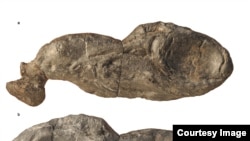Sharks may not be “living fossils,” as was once thought.
Researchers say analysis of a 325-million-year-old shark skeleton could “profoundly affect our understanding of evolutionary history.”
Using a fossil of the newly discovered Ozarcus mapesae specimen, scientists at the American Museum of Natural History in New York had a unique chance to study a fossilized skeleton preserved in 3D, according to the researchers.
Since shark skeletons are made of cartilage, fossilized specimens are usually flattened, making it difficult to understand how they were structured.
“Sharks are traditionally thought to be one of the most primitive surviving jawed vertebrates. And most textbooks in schools today say that the internal jaw structures of modern sharks should look very similar to those in primitive shark-like fishes,” said Alan Pradel in a statement.
“But we’ve found that’s not the case. The modern shark condition is very specialized, very derived, and not primitive,” said Pradel, a postdoctoral researcher at the museum and the lead author of the study.
According to the researchers, fish heads, including sharks, “are segmented into the jaws and a series of arches that support the jaw and the gills.” The arches were thought to have developed into jaws in early in evolution.
“This beautiful fossil offers one of the first complete looks at all of the gill arches and
associated structures in an early shark. There are other shark fossils like this in existence, but this is the oldest one in which you can see everything,” said John Maisey, a curator in the Museum’s Division of Paleontology and one of the authors on the study.
“There’s enough depth in this fossil to allow us to scan it and digitally dissect out the cartilage skeleton,” he said. Using x-rays, scientists were able to view the shape and organization of the arches.
“We discovered that the arrangement of the arches is not like anything you’d see in a modern shark or shark-like fish,” said Pradel. “Instead, the arrangement is fundamentally the same as bony fishes.”
Scientists said that while sharks have been around for 420 million years, it would not be unexpected to see some evolution in their arch and jaw structures, leading to the conclusion that they may not be quite the window to the past as previously thought.
“Bony fishes might have more to tell us about our first jawed ancestors than do living sharks,” Maisey said.
The Ozarcus mapesae fossil was found in Arkansas, which was once home to an ocean basin that housed a diverse set of ancient marine life.
The research is published this week in the journal Nature.
Researchers say analysis of a 325-million-year-old shark skeleton could “profoundly affect our understanding of evolutionary history.”
Using a fossil of the newly discovered Ozarcus mapesae specimen, scientists at the American Museum of Natural History in New York had a unique chance to study a fossilized skeleton preserved in 3D, according to the researchers.
Since shark skeletons are made of cartilage, fossilized specimens are usually flattened, making it difficult to understand how they were structured.
“Sharks are traditionally thought to be one of the most primitive surviving jawed vertebrates. And most textbooks in schools today say that the internal jaw structures of modern sharks should look very similar to those in primitive shark-like fishes,” said Alan Pradel in a statement.
“But we’ve found that’s not the case. The modern shark condition is very specialized, very derived, and not primitive,” said Pradel, a postdoctoral researcher at the museum and the lead author of the study.
According to the researchers, fish heads, including sharks, “are segmented into the jaws and a series of arches that support the jaw and the gills.” The arches were thought to have developed into jaws in early in evolution.
“This beautiful fossil offers one of the first complete looks at all of the gill arches and
associated structures in an early shark. There are other shark fossils like this in existence, but this is the oldest one in which you can see everything,” said John Maisey, a curator in the Museum’s Division of Paleontology and one of the authors on the study.
“There’s enough depth in this fossil to allow us to scan it and digitally dissect out the cartilage skeleton,” he said. Using x-rays, scientists were able to view the shape and organization of the arches.
“We discovered that the arrangement of the arches is not like anything you’d see in a modern shark or shark-like fish,” said Pradel. “Instead, the arrangement is fundamentally the same as bony fishes.”
Scientists said that while sharks have been around for 420 million years, it would not be unexpected to see some evolution in their arch and jaw structures, leading to the conclusion that they may not be quite the window to the past as previously thought.
“Bony fishes might have more to tell us about our first jawed ancestors than do living sharks,” Maisey said.
The Ozarcus mapesae fossil was found in Arkansas, which was once home to an ocean basin that housed a diverse set of ancient marine life.
The research is published this week in the journal Nature.










